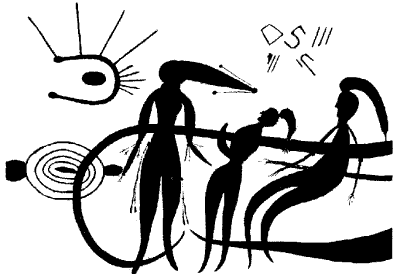 |
Science Frontiers ONLINE No. 117: May-June 1998 |
|
|
Aliens, Mystery Races, Or Aborigines?
Some of Australia's rock art -- the Wandjina paintings -- depicts humanoids in fulllength gowns with strange halos encircling their heads. Those favoring the "ancient astronaut" theory assure us that the Wandjina figures are those of alien visitors! The so-called Bradshaw paintings don't fit in the "alien" category but they are so interesting that we choose to reproduce one here. It raises three problems: (1) The slim, flowing human figures remind one more of the Tassili rock art found in Africa's Sahara rather than that of the Australian Aborigines; (2) The objects at the left are enigmatic and technical-looking; and (3) The symbols (?) at the top are undeciphered.
The article at hand from Antiquity does not attempt to interpret the Bradshaw art. Instead, it discusses the social factors that mold the interpretation of the Wandjina and Bradshaw paintings. When Europeans first saw these paintings they were certain that their "advanced style" was far beyond the capabilities of the Aborigines (colonial prejudice). They must, therefore, be the work of "preAborigines." Today's Aborigines will have none of this condescension. They were the original settlers of Australia, and as such they have bona fide land and title claims. Any recognition of "pre-Aborigines" would undercut these claims.
(McNiven, Ian J., and Russell, Lynette; "'Strange Paintings' and 'Mystery races': Kimberly Rock-Art, Diffusionism and Colonialist Constructions of Australia's Aboriginal Past," Antiquity, 71:801, 1997.)
Comment. In New Zealand, the Maoris insist they were the first settlers, despite evidence to the contrary. The Maoris, too, have land claims.
